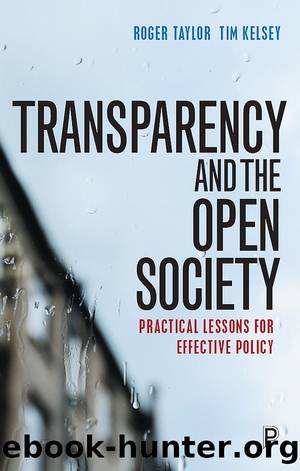Transparency and the Open Society: Practical Lessons for Effective Policy by Roger Taylor & Tim Kelsey

Author:Roger Taylor & Tim Kelsey [Taylor, Roger & Kelsey, Tim]
Language: eng
Format: epub
Tags: General, Social Science, Political Science, Public Affairs & Administration
ISBN: 9781447325369
Google: 1wVpDwAAQBAJ
Goodreads: 29361972
Publisher: Policy Press
Published: 2016-09-15T00:00:00+00:00
Evidence that Social Audit works in developing economies
In India, social audit was made a mandatory part of the Mahatma Ghandi National Rural Employment Guarantee Act (MNREGA), which guaranteed a minimum amount of employment for people volunteering for work in rural communities. Implementation was delayed in many parts of the country, for example in Rajasthan, because bureaucrats objected to the involvement of âoutsidersâ in the supervision of their work.
The implementation of the scheme in the state of Andra Pradesh (AP) has been held up as a model example of how to do it. Audit teams were trained and given unrestricted access to the books of the project administrators. Public hearings were held regularly to review the audit findings. Compared to other states, Andra Pradeshâs thorough implementation of social audit has been associated with an improved performance.2
Some assessments of the impact audits in AP were less enthusiastic. Work by Farzana Afridi and Vegard Iversen found only modest evidence of a reduction of misappropriation of funds.3 There was clear evidence of reduction in the type of corruption easiest to detect â the failure to offer work or pay wages. But they saw a trend towards substituting harder to detect acts, such as purchasing low-grade materials but booking the cost of high-grade materials, for easy to detect acts such as not paying wages.
The problem, they suggest, is not simply that one is harder to spot than the other. The reason is also that the cruder forms of corruption are perpetrated by low-level local functionaries who could be effectively shamed and held to account in the meetings. In contrast, those higher up the chain were immune. If a scam was uncovered, that particular form of misappropriation might be put right. But official sanctions were rarely used against those discovered to have done wrong. For the officials involved there was little or no risk in simply coming up with some new system to divert the funds.
Similar conclusions were reached in Indonesia. There, efforts to engage local communities in overseeing the spending of money on road-building programmes had no effect on the levels of corruption or the efficiency with which public resources were used.
In contrast to these stories, there are some very clear examples of social audit working. One of the more celebrated examples was in Uganda of information where money paid to schools was published in newspapers throughout the country. The intention was that âsocial auditâ â the public noticing and complaining if they saw that the money for their schools was not being spent on their schools â would reduce the amount stolen en route as the money travelled through layers of bureaucracy from the national treasury to the local classroom. Analysis of the results showed a clear pattern in which the amount of money that âleakedâ along the way fell overall, and fell more the closer the school was to an outlet selling newspapers. Subsequent studies have shown that initial estimates of the impact of publication may have overstated the effect by failing to
Download
This site does not store any files on its server. We only index and link to content provided by other sites. Please contact the content providers to delete copyright contents if any and email us, we'll remove relevant links or contents immediately.
The Secret History by Donna Tartt(18952)
The Social Justice Warrior Handbook by Lisa De Pasquale(12170)
Thirteen Reasons Why by Jay Asher(8849)
This Is How You Lose Her by Junot Diaz(6839)
Weapons of Math Destruction by Cathy O'Neil(6221)
Zero to One by Peter Thiel(5736)
Beartown by Fredrik Backman(5683)
The Myth of the Strong Leader by Archie Brown(5463)
The Fire Next Time by James Baldwin(5390)
How Democracies Die by Steven Levitsky & Daniel Ziblatt(5175)
Promise Me, Dad by Joe Biden(5117)
Stone's Rules by Roger Stone(5055)
A Higher Loyalty: Truth, Lies, and Leadership by James Comey(4909)
100 Deadly Skills by Clint Emerson(4883)
Rise and Kill First by Ronen Bergman(4741)
Secrecy World by Jake Bernstein(4703)
The David Icke Guide to the Global Conspiracy (and how to end it) by David Icke(4660)
The Farm by Tom Rob Smith(4469)
The Doomsday Machine by Daniel Ellsberg(4453)
